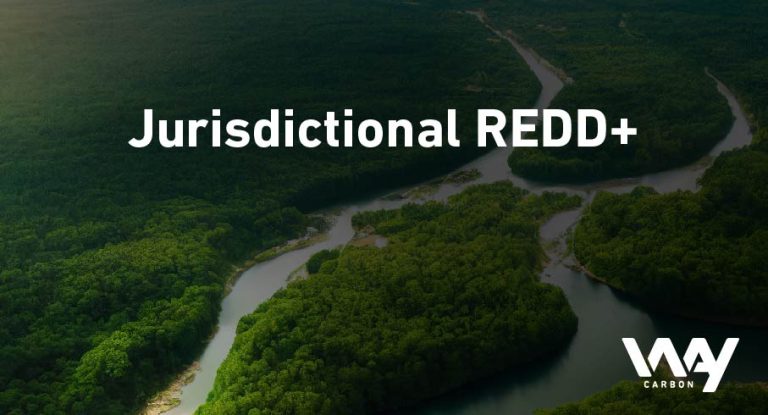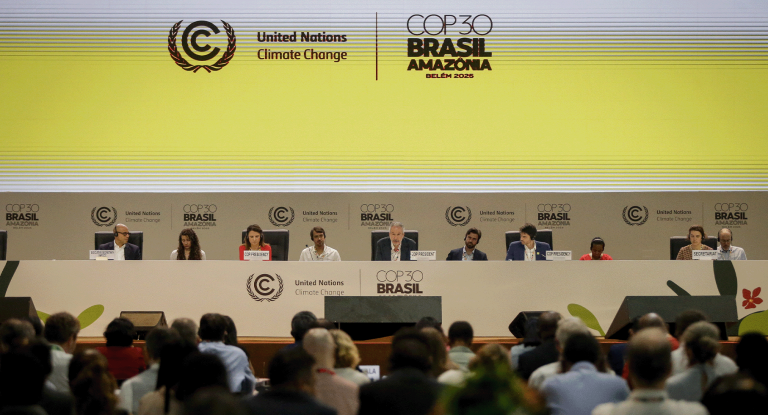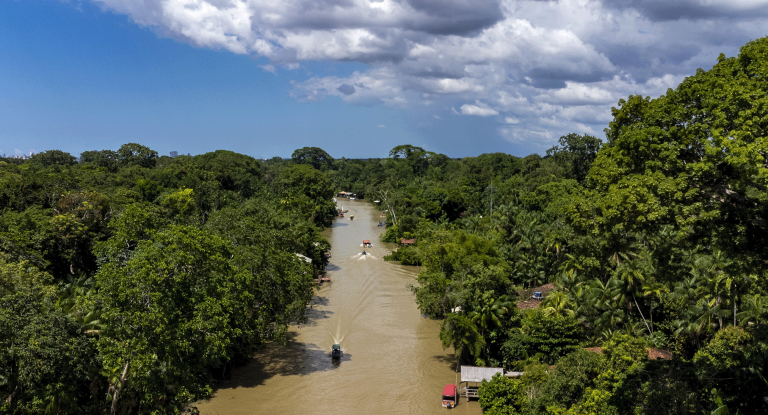Advantages and challenges of the jurisdictional REDD+approach

Brazil’s six biomes – Amazon, Cerrado, Atlantic Forest, Caatinga, Pampa and Pantanal – contain around 20% of the world’s biodiversity and 12% of the planet’s freshwater reserves. This diversity is responsible for the quantity and quality of several ecosystem services on which society depends to function, such as climate regulation, maintenance of air and water quality, erosion control, pollination, and pest control in agriculture, among others. Nature-based economic activities can contribute more than R$ 2.8 trillion to Brazil’s GDP by 2030 (WRI, 2020), and the areas of legal reserves alone help preserve a heritage of at least R$ 6 trillion in the national territory (Metzger et al., 2019).
Nevertheless, deforestation – and degradation – of ecosystems continues on a large scale and has been increasing in recent years. In 2021 alone, 16,557 km² of land was deforested, a 20% increase in the deforested area compared to 2020. Studies also show that degradation is responsible for an equal amount of GHG emissions and even greater biodiversity loss. Annual emissions due to deforestation between 2001 and 2018 are estimated to have fluctuated from 183 to 733 MtCO2e, while degradation was responsible for adding 220 to 770 MtCO2e to the atmosphere each year (Lapola et al., 2023).
So, how can we reverse the disconnect between the value generated by forests for society and the decision-making process to avoid deforestation? In addition to law enforcement to combat illegal activities, promoting financial incentives can be an important tool to enable the conservation and sustainable use of biodiversity, and thus protect forest areas.
A study conducted by WayCarbon estimated that there is a potential for reducing emissions by 365 million tCO2e annually through avoided deforestation in the Brazilian Amazon states, equivalent to 15% of emissions in 2021. These conservation activities could generate revenues of approximately US$ 3 billion per year through the payment for GHG emission reductions. The study also details other potentials of Nature-Based Solutions.
In this context, mechanisms related to Reducing Emissions from Deforestation and Forest Degradation (REDD+, where the “+” sign stands for other elements such as conservation and sustainable management) remain crucial for generating the necessary financial flows to implement projects that value the extent and integrity of natural ecosystems.
As stated at COP26, the climate crisis cannot be solved without nature. The LEAF Coalition (Lowering Emissions by Accelerating Forest Finance), created on this occasion in Glasgow, has just launched another call for proposals to provide financial support to countries that successfully reduce their emissions from deforestation and forest degradation. The submission window is open from 1 May 2023 to 1 May 2024 (the “Third Proposal Window”).
What are the challenges?
Just as in the 2002 film “Minority Report” starring Tom Cruise (based on the novel of the same name), about a police force that fights crimes before they happen, we will never be able to provide clear evidence of a specific result of avoided deforestation. The implementation of REDD+ projects is inherently fraught with uncertainties and therefore challenges regarding their real benefits.
However, much like when a city invests in a public transport system and sees a reduction in the use of private cars, actions to promote the conservation of natural ecosystems can statistically demonstrate that the forest is no longer being cleared (or degraded) as a result of these actions. REDD+ initiatives provide concrete results that can be verified through models based on territorial data and monitoring of results.
Monitoring, Reporting, and Verification (MRV) Technologies, including high-resolution imagery, developments in the use of Light Detection and Ranging (LIDAR) and innovative mathematical models, are increasingly being used to improve the reliability of these calculations and to minimise the associated risks.
Nevertheless, these technologies do not eliminate all the challenges associated with project-based REDD+ initiatives. The main challenges for project-based REDD+ initiatives are:
- “Inflated” baselines due to poor choice of reference areas.
- Underestimation of deforestation, including leakage to areas outside the project that are not being monitored.
- Permanence risk due to future forest loss.
- Risks associated with property rights and land tenure.
Why take the jurisdictional approach?
These are some of the reasons why private financing sources, such as the LEAF Coalition, have sought ways to pay for jurisdictional (national and state-based) initiatives based on results rather than individual projects. Jurisdictional REDD+, which is not a new idea, brings several advantages that help overcome these challenges:
- By accounting for deforestation throughout the jurisdiction, baselines are better calibrated to the broader dynamics, reducing the risk of generating credits that do not represent a real reduction in CO2e emissions from a reference scenario.
- As monitoring should take place in all areas of the jurisdiction, leakage from deforestation is detected and not included in the calculation of results.
- The costs of MRV, which are typically high, will be shared and by ensuring greater efficiency in the use of resources, will reduce financial barriers to implementing REDD+ efforts.
- The involvement of governments in these programs will facilitate the creation and regulation of public policies aimed at achieving defined objectives, beyond what is typically achieved by project-based REDD+.
What are the prospects for jurisdictional REDD+ in the carbon market in the coming years?
In addition to new funding opportunities, such as the LEAF “Third Proposal Window” mentioned above, new market standards are being developed (such as ART-TREES and VERRA-JNR) that will add robustness to the process of issuing reduction certificates. There are also several ongoing initiatives aimed at promoting jurisdictional approaches to REDD+, such as the PLANT tool (Paris Agreement LULUCF and NDC tool).
Launched during COP27, the PLANT tool (available at climateandforests-undp.org/plant) is a digital, interactive tool that brings together a comprehensive database, constantly updated from public sources and validated by international experts, with national and sub-national information from 56 forested countries. The initiative is from the United Nations Development Programme (UNDP), with support from WayCarbon.
PLANT is expected to support countries in their process of submitting jurisdictional REDD+ proposals under the ART-TREES standard in a number of ways, including:
- Preliminary assessment of national and subnational jurisdictions’ compliance with jurisdictional REDD+ market standards; and
- Assessment of emission reduction potential based on simulations that vary by jurisdiction and the potential year of submission to the market standard, and also take into account the discount of other pay-for-results carbon initiatives.
The involvement and leadership of Brazilian state governments in REDD+ programmes, particularly in the Amazon biome, offer excellent opportunities for Brazil to promote nature-based climate change mitigation actions.
References
MapBiomas, 7 Facts about Indigenous Territories in Brazil. 2023
Joly, C. A. et al. 1st Brazilian Diagnostic of Biodiversity and Ecosystem Services. 2019. Available at: https://www.bpbes.net.br/wp-content/uploads/2019/09/BPBES_Completo_VF-1.pdf
WEF, Global Risks Report. 2021
Annual Deforestation Report 2021 – São Paulo, Brazil MapBiomas, 2022 https://s3.amazonaws.com/alerta.mapbiomas.org/rad2021/RAD2021_Completo_FINAL_Rev1.pdf
LAPOLA, D.M et al. The drivers and impacts of Amazon forest degradation, Science. 2023 https://www.science.org/doi/10.1126/science.abp8622
LEAF, Call for Proposals. 2023 (available at: https://leafcoalition.org/wp-content/uploads/2023/05/LEAF-CFP-Terms-3rd-Window_PT.pdf)
VERRA, Response to Guardian Article on Carbon Offsets. 2023 (available at: https://verra.org/verra-response-guardian-rainforest-carbon-offsets/)
https://www.climateandforests-undp.org/plant
https://stories.climateandforests-undp.org/womenleadingtheway/
https://www.oc.eco.br/wp-content/uploads/2023/03/SEEG-10-anos-v4.pdf
https://report.ipcc.ch/ar6syr/pdf/IPCC_AR6_SYR_LongerReport.pdf
GRISCOM, B. W. et al. National mitigation potential from natural climate solutions in the tropics. Philosophical Transactions Royal Society. 2020
METZGER, J. P. et al. Why Brazil needs its Legal Reserves. Perspectives in Ecology and Conservation. 2019 https://www.sciencedirect.com/science/article/pii/S253006441930118X?via%3Dihub
WRI, A New Economy for a New Era: Elements for Building a More Efficient and Resilient Economy for Brazil. 2020
Sylvera, An introduction to Jurisdictional REDD+. 2022 (available at: https://www.sylvera.com/blog/an-introduction-to-jurisdictional-redd)
http://terrabrasilis.dpi.inpe.br/app/dashboard/deforestation/biomes/legal_amazon/rates
 EN
EN  ES
ES PT
PT








